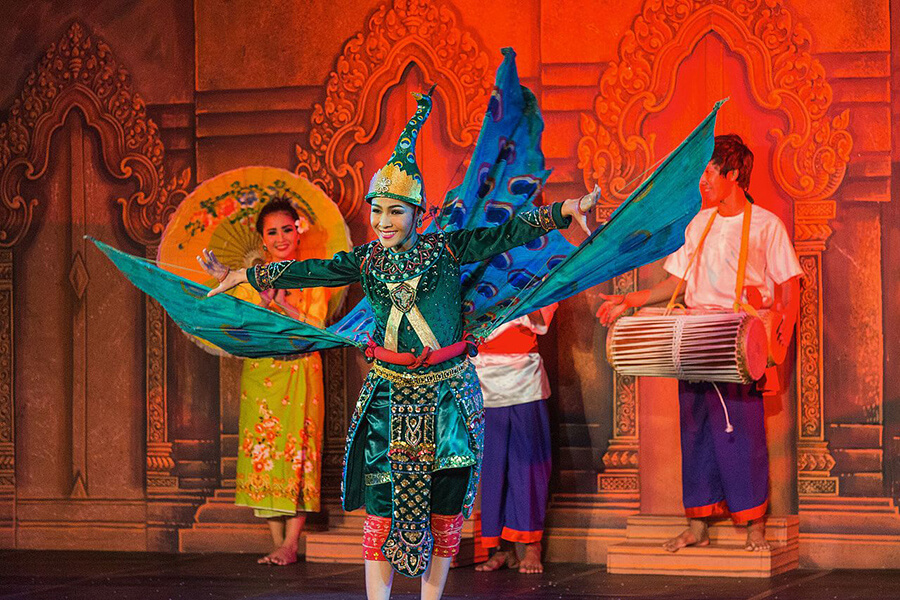In the heart of Southeast Asia, where the Mekong River gracefully flows, lies a land steeped in rich cultural heritage – Laos. Amidst its serene landscapes and vibrant temples, the Lao people have preserved a treasure trove of art forms, one of which stands out as a captivating embodiment of their spirit: Laotian dance.A Symphony of Movement and TraditionLaotian dance is not merely a performance; it is a symphony of movement, a tapestry woven with threads of tradition, pride, and the unyielding joy of life. Each step, each sway, each gesture carries a deeper meaning, a connection to the land, the ancestors, and the very essence of Lao identity.The traditional dances of Laos hold a significant place within the heart of Lao culture. They serve as a mirror reflecting the deep-rooted pride of the nation, an unwavering respect for age-old customs, and the sheer exuberance of life itself. Within this realm of Lao dance, a rich tapestry of diverse forms and styles emerges, each with its distinctive essence and profound significance.
Traditional Dances in Laos
Romvong – Traditional Dances in Laos
Lamvong, an age-old traditional dance rooted in the historical tapestry of the Lan Xang Kingdom, stands as an enduring emblem of Lao culture and its intrinsic identity. This enchanting dance, a testament to Lao heritage, finds its spotlight during festive revelries, weddings, and other momentous occasions, where its ethereal presence weaves a captivating narrative.
In the Lamvong dance, a mesmerizing circle of dancers comes together, their hands gently entwined, forming a symbolic connection between past and present. With graceful and fluid footwork, they traverse the dance floor, their bodies swaying in harmony with the melodious cadence of the music. The traditional sounds of Laos, borne by instruments like the khaen, a bamboo mouth organ, and the pi, a dulcet flute, lend an enchanting aura to the performance.
Lamvong, with its graceful and poetic choreography, encapsulates the beauty and grace that permeates the heart of Lao culture. It serves as a joyful ode to life and a unifying force that brings people together in celebration of their shared heritage and community.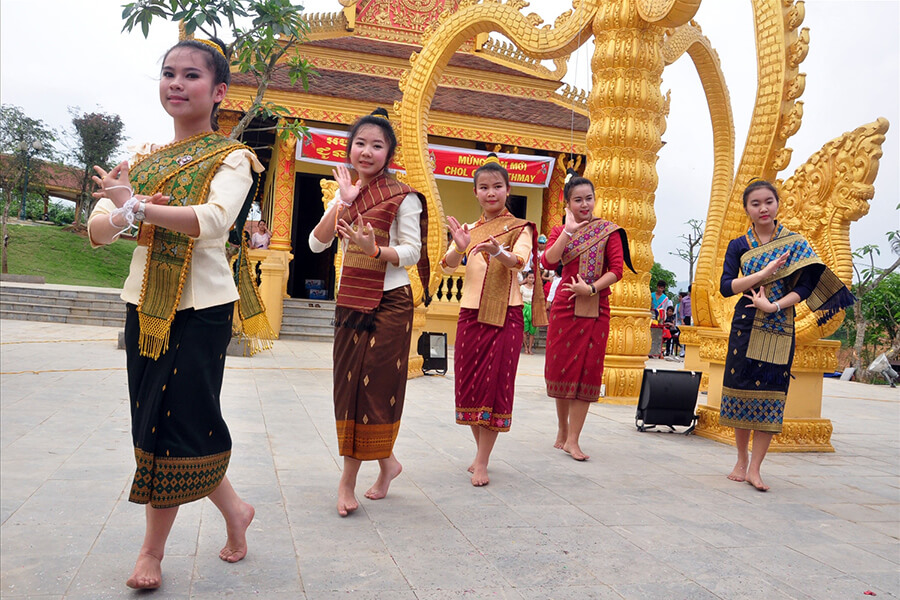
Xi-nuon – Traditional Dances in Laos
The enchanting Xỉ Nuôn dance, deeply rooted in the cultural heritage of the Lao people, traces its origins to the picturesque province of Xieng Khoang. This traditional dance takes center stage during a myriad of festivals, with the grand Xỉ Nuôn festival held annually in the month of November, an occasion that marks its exuberant celebration.
Xỉ Nuôn dance is a heartfelt performance by the youth, a poignant portrayal of love shared between couples, an unwavering bond with their beloved homeland, and a vibrant ode to the sheer joy of life itself.
The dance unfolds with young men and women gracefully aligning themselves in two facing rows. As the rhythmic beat of the drums sets the tempo, their movements become a symphony of grace and rhythm. It’s a dance that speaks of love through gestures, from the tender clasp of hands to affectionate embraces and even fleeting kisses.
Amidst the dance’s embrace, the voices of the young men and women are raised in song, singing the soulful melodies of traditional Lao folk tunes. These lyrical verses pay homage to the profound love between couples, the enduring ties to their homeland, and the radiant delight of existence.
Xỉ Nuôn dance serves as a vivid tapestry of Laos’ cultural legacy. It is a unique and cherished expression of the Lao people, a living testament to the beauty of tradition and the unbreakable bonds of love and heritage.
Ko-that – Traditional Dances in Laos
Kò Thạt dance, a venerable treasure among the traditions of the Lao people, finds its origins in the picturesque province of Savannakhet. This timeless performance takes center stage during religious festivals, most notably the resplendent Vesak festival, a cherished annual observance held in the month of April.
Kò Thạt dance carries with it an air of solemnity, as it unfolds primarily through the graceful movements of Lao men, who pay homage to the divine presence of Lord Buddha. The dance is a profound expression of reverence, a heartfelt tribute to the spiritual essence that pervades the hearts of the Lao people.
The dance commences with a solemn formation of men standing in reverent alignment, facing the solemn majesty of a Buddha shrine. As the rhythmic pulse of the drums beckons, their movements unfold with a mesmerizing grace and rhythm. Each step and gesture, whether it’s the gentle palm-to-palm salutations or the humble bowing, echoes the deep-seated respect for Lord Buddha’s teachings.
Amidst the dance’s poignant cadence, the voices of the men rise in harmony as they sing religious hymns. These melodies are a melodious offering, praising Lord Buddha and invoking blessings of peace upon the nation and its people.
Kò Thạt dance is a living embodiment of the cultural tapestry that defines Laos. It stands as a unique and cherished facet of Lao heritage and culture, a testament to the enduring spirit of devotion and reverence that continues to flourish in the hearts of the Lao people.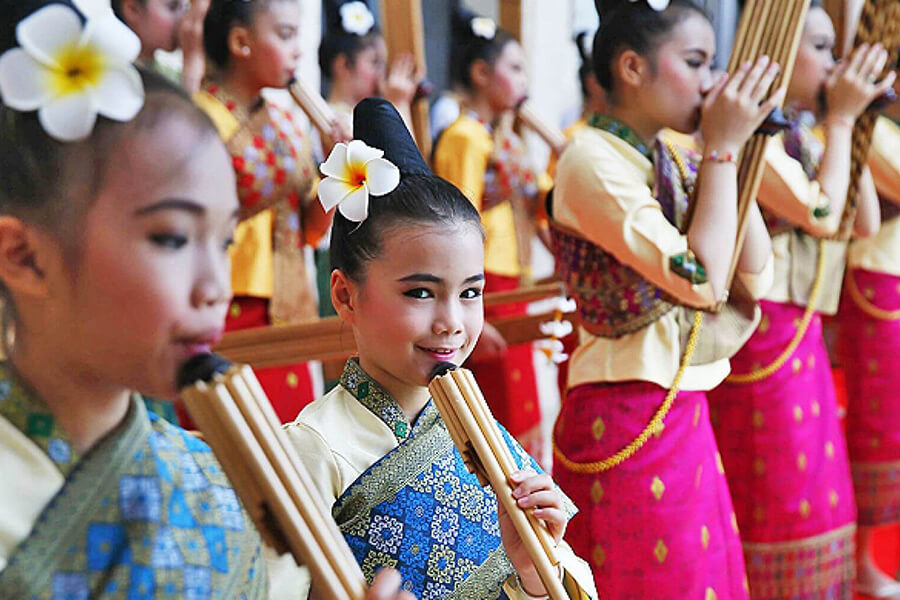
dooc bua – Traditional Dances in Laos
The captivating Đoọc Bua Dance, often pronounced as “mú doóc bù-a,” is a venerable masterpiece of traditional storytelling through dance hailing from the heart of Laos. It takes center stage at a multitude of celebrations, particularly during festivals and special gatherings, where its entrancing narrative unfolds.
This artistic performance is orchestrated by a group of dancers who don traditional Lao attire, adding an authentic flair to the spectacle. With every sinuous movement of their bodies and the expressive sway of their arms, the dancers artfully weave tales through graceful gestures, creating a visual poetry that transcends mere dance. These stories may encompass a vast spectrum of subjects, ranging from the rich tapestry of Lao history to the breathtaking marvels of nature.
The Đoọc Bua Dance is a splendid and eloquent artistic expression that stands as a unique pillar within Lao culture. It is a dance that exalts the boundless realms of creativity and storytelling prowess among the Lao people.
Delving deeper into the heart of this captivating performance:
The dancers, typically comprised of young women but with the inclusion of men, are adorned in traditional Lao attire, an embodiment of the nation’s heritage. Women often grace themselves with the elegant sinh, while both men and women drape themselves in the pha biang, a symbol of grace and refinement.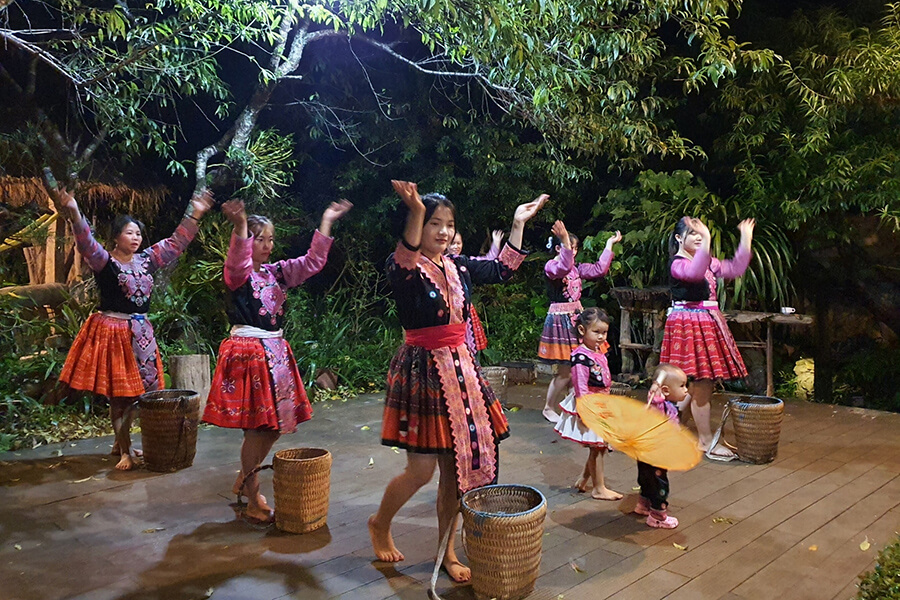
The choreographed movements are a symphony of grace and expression. Dancers fluidly employ their bodies and arms to communicate tales, making every gesture a brushstroke in the canvas of storytelling. The stories they convey can be as diverse as the annals of Lao history or as profound as the natural wonders that grace the landscape.
The accompanying music enveloping the performance is a resonant celebration of Lao tradition, featuring the enchanting sounds of instruments like the khaen, a mellifluous bamboo mouth organ, the soulful pi, a flute, and the dulcet tones of the cong, traditional bells.
The Đoọc Bua Dance is an exquisite testament to the creative brilliance and storytelling prowess of the Lao people, embodying the very essence of their cultural identity. It is a resplendent tribute to the art of narrative and the profound tales woven into the fabric of Lao heritage.
Traditional Dances in Cambodia
Apsara Dance – in Cambodia
The enchanting Apsara Dance, a classical Cambodian art form dating back to the 7th century, weaves a tapestry of history, mythology, and culture. A journey through the ancient temples of Angkor, a UNESCO World Heritage site, offers visitors a profound glimpse into the pivotal role of the Apsara Dance within Khmer heritage. Adorning the temple walls and bas-reliefs are intricately carved images of apsara dancers, emphasizing the dance’s paramount significance.
Rooted in both Hindu and Buddhist mythologies, the Apsaras, often depicted as celestial nymphs, are believed to have descended from heaven to Earth to captivate gods and kings with their bewitching performances. In the 12th century, King Jayavarman VII is said to have maintained a royal court with over 3,000 Apsara dancers, underscoring the esteemed status of this ancient art form.
Apsara Dance unfolds with deliberate grace, enthralling spectators with its slow, hypnotic, and gentle movements, a reflection of the notion that these celestial spirits ensnare mortals with their celestial beauty. It’s a dance where every nuance matters, and hand gestures take center stage. Each finger movement carries its own distinct meaning, requiring some dancers to bend their fingers nearly to their wrists to execute intricate choreography.
A hallmark of the Apsara Dance is its elaborate traditional costumes, which mirror the majestic grace of the performers. Dancers are adorned in elegant silk garments embellished with intricate floral motifs, resplendent jeweled headdresses, and dazzling accessories like necklaces, earrings, bracelets, and anklets. The opulence of their attire resonates with the richness of their movements.
Tragically, the Apsara Dance, like many aspects of Cambodian culture, faced near extinction during the brutal reign of the Khmer Rouge regime from 1975 to 1979. Apsara dancers were not spared in the massacre orchestrated by Pol Pot’s regime. Fortunately, a handful of surviving dancers preserved the tradition, passing on their knowledge and skills to the younger generations.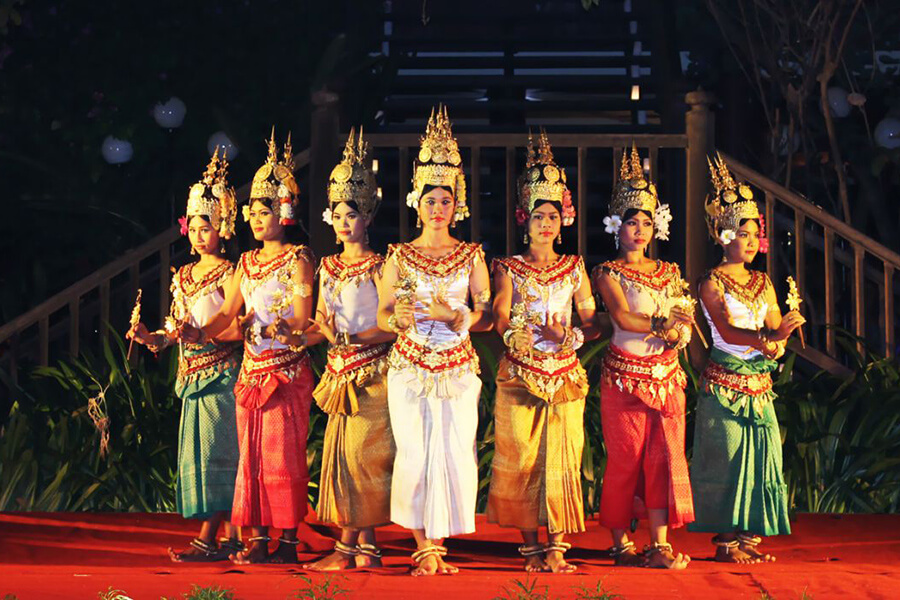
A pivotal moment in the resurgence of the Apsara Dance came when Queen Sisowath Kossomak Nearirath Serey Vatthana, wife of King Norodom Suramarit, visited the Sothearath primary school in the 1940s. Witnessing a captivating Angkor Apsara dance performance by young schoolchildren clad in paper apsara costumes, she was inspired to rekindle the art. She embarked on the training of her own daughter, Princess Bopha Devi, who began her journey into Apsara dance at the tender age of five. Princess Bopha Devi would go on to become the first professional Apsara dancer, rekindling and preserving this treasured Cambodian tradition.
In a momentous acknowledgment of its cultural significance, the Apsara Dance was granted UNESCO recognition in 2003 as the “Masterpiece of Oral and Intangible Heritage of Humanity.” This accolade underscores its enduring status as a living testament to the artistic and historical richness of Cambodia, a testament to the indomitable spirit of those who safeguarded its legacy through the darkest of times.
Blessing Dance – in Cambodia
The Cambodian Blessing Dance, known as Robam Choun Por in the melodious Khmer language, is an ancient and cherished tradition that graces the commencement of ceremonies and special events in the heart of Cambodia. This captivating dance is a poignant invocation, a heartfelt prayer for the bestowing of health, happiness, prosperity, and the triumphant fruition of endeavors.
Elegantly poised and meticulously attired in the resplendent vestments of the Khmer Classical Royal Ballet, a group of young Khmer girls, numbering in odd clusters of three, five, or seven, embody the embodiment of the Devata, celestial beings who carry the sacred wishes of the divine. With each performer carrying a gleaming golden goblet, its interior adorned with an array of meticulously selected flower blossoms—fragrant jasmine, pristine lotus, or vibrant Romdoul—symbolizing the very blessings bestowed by the gods.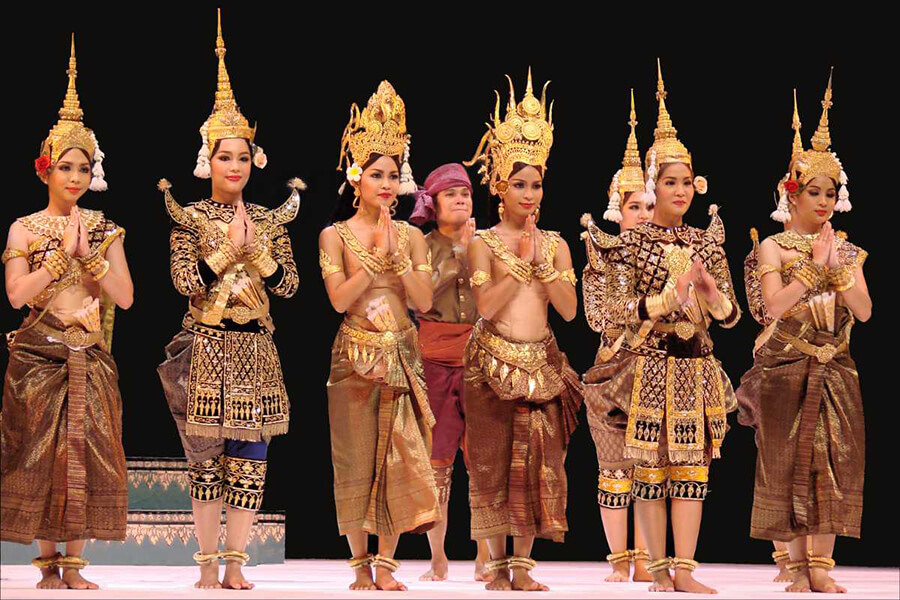
As the dance unfolds, the graceful movements of these young dancers come to life. They cradle the golden goblets, each containing a trove of delicate blossoms, in their skilled hands. With every gesture and turn, they pluck these fragrant offerings and, with reverence, cast them gently towards the audience. It is a poignant and symbolic act, each blossom a whispered prayer, each gentle toss an earnest wish extended from the depths of their hearts.
The Cambodian Blessing Dance is an enchanting embodiment of hope, a poetic ritual that bridges the earthly realm with the divine. With every graceful movement and delicate blossom, it carries the aspirations of a nation, a dance that resonates with the promise of a brighter, more prosperous future. It stands as a living testament to the artistry and spirituality of Cambodia, a dance that embraces the aspirations of the Khmer people with enduring grace.
Folk Dances in Cambodia
Cambodian Folk Dances, a vibrant mosaic of tradition, serve as poignant and evocative reflections of the rich cultural tapestry and the diverse ethnic groups that comprise Cambodia. In stark contrast to the poised elegance of classical dances, these folk dances surge with spirited vitality, characterized by brisk, exuberant movements and a raw, unvarnished authenticity. They are a living embodiment of the soul of Cambodia.
Folk dancers don attire that signifies their embodiment of various roles and cultural backgrounds. From the Chams to the hill tribes, from farmers to peasants, these dancers immerse themselves in the spirit of the people they portray, a visual tribute to the country’s diversity.
To the backdrop of a mahori orchestra, the heart of Cambodian folk dance beats. This musical ensemble, composed of stringed and plucked instruments, resonates with the soul of Cambodia, serenading the dancers and audience alike. The melodic strains of flutes add a lyrical dimension to the performance, creating a harmonious and captivating experience.
Cambodian folk dances are not mere exhibitions; they are ceremonial, spiritual, and deeply rooted in the soil of tradition. They are rarely staged in the public domain and are reserved for the sacred rituals, grand celebrations, and momentous holidays that bond rural communities. These dances are an ode to rural life, an homage to practices and customs born from the Cambodian countryside.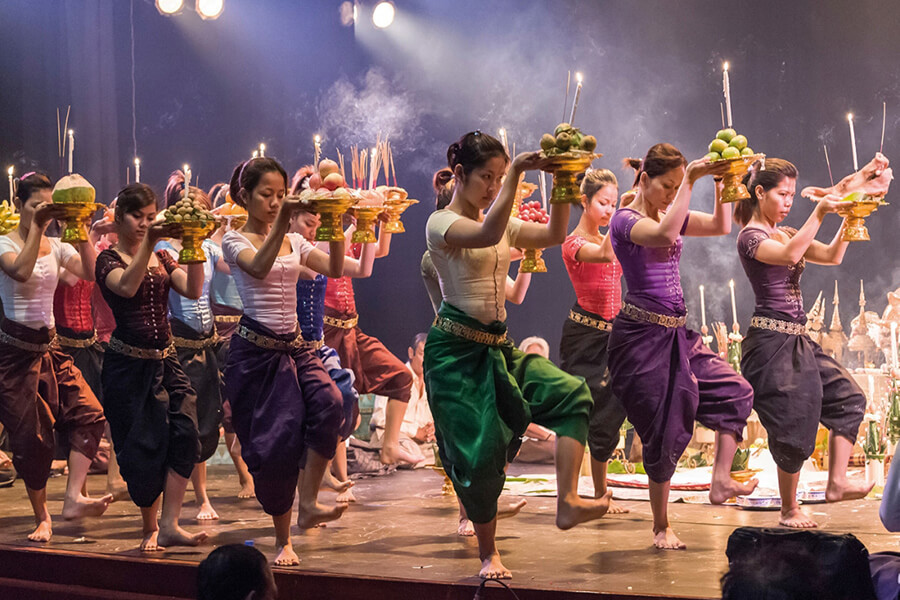
Within the realm of Cambodian folk dances, there exists a profusion of captivating narratives, each imbued with unique meanings and stories. These dances encapsulate the essence of a nation, echoing with the melodies of its diverse communities, and are a testament to the enduring spirit of Cambodia’s cultural heritage.

